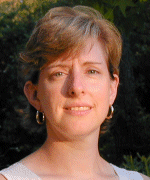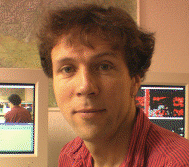Networks of Smart 3D sensors


john![]() woodfill.com,
gaile
woodfill.com,
gaile![]() alum.mit.edu
alum.mit.edu
Seminar on People, Computers, and Design
Stanford University March 4, 2005
Of all our human senses, we rely most on our sense of sight to interact with the world. As we incorporate embedded processors into everyday products to make them more intelligent, we can imbue them as well with this powerful capability. To date, however, machine vision has only achieved success in manufacturing facilities where lighting and scene variation are strictly controlled. Seeing in the real world is harder.
The challenge to seeing is to view the world in real-time in three dimensions and color. Technology developed by Tyzx performs the task on a single IC, the DeepSea, at rates that outstrip the fastest CPUs.
Embedding the DeepSea with commodity CMOS imagers and a general-purpose processor
creates a smart 3D sensor. Smart 3D sensors enable new applications from automotive
obstacle avoidance and occupant sensing to new interactive video games. Networks
of smart 3D sensors create a distributed, self-configuring, scalable sensor
capable of observing and integrating events over a large area. Such networks
can be used to track people in large, crowded, dynamic environments such as
airports.
Gaile Gordon is Vice President of Advanced Development and a founder of Tyzx. Prior to Tyzx, she led research on visual person tracking at Interval Research Corporation. This work at Interval, along with the development of ground breaking high speed stereo vision hardware by co-founder John Woodfill, form the core of current Tyzx 3D imaging technology. Previously Gaile was at TASC, Inc. where she was the Principal Investigator of a DARPA research contract focused on 3D face recognition. She holds a Bachelors and Masters Degree in Computer Science and Engineering from MIT and a PhD from Harvard in Computer Vision.
Dr. John Woodfill initiated and led Interval's research on computational stereo vision. He is known for his research in frame-rate depth and motion vision for systems that work in the real world. This focus has led to patented, stereo vision hardware that is at the core of our 3D imaging technology. The current realization of this hardware represents orders of magnitude more computational ability and lower cost than competing stereo computation engines. His thesis work resulted in interactive robotic systems that tracked people (and cats) in unstructured environments based solely on estimates of optical flow. Dr. Woodfill was previously a consultant at Xerox PARC and SRI, and a Visiting Scientist at the IBM Science Center in Heidelberg, Germany. He was also a member of the original team that developed the INGRES relational database system at UC Berkeley. He holds a dual AB degree from UC Berkeley in Computer Science and Philosophy, and an MS degree and PhD from Stanford in Computer Vision.
View this talk on line at CS547 on Stanford OnLine
Titles and abstracts for previous years are available by year and by speaker.